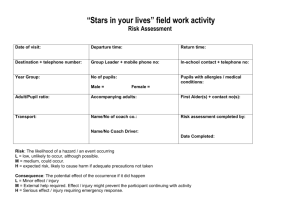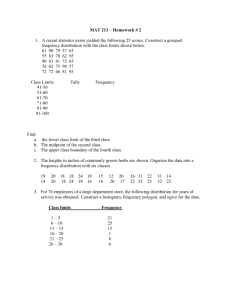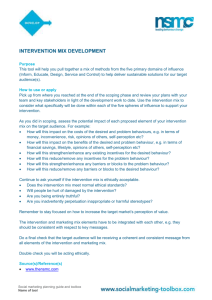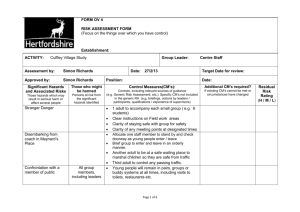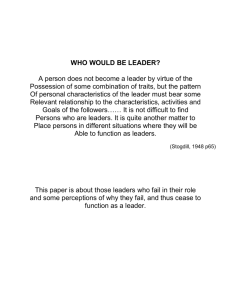msword
advertisement
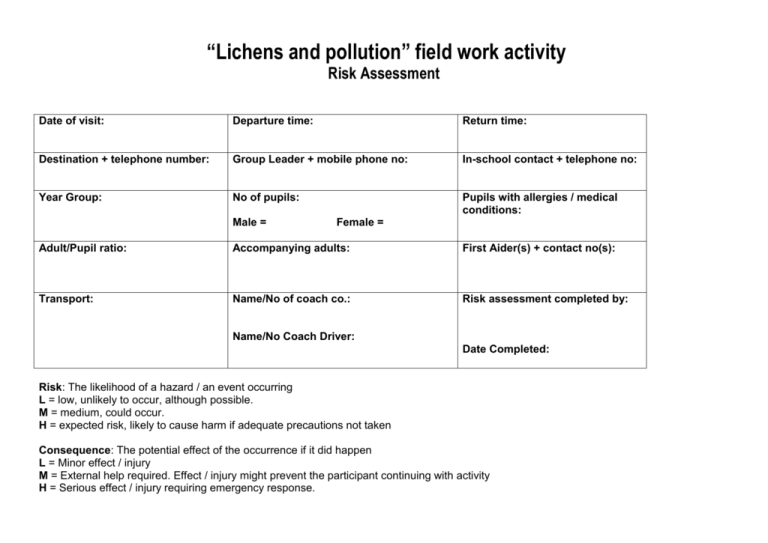
“Lichens and pollution” field work activity Risk Assessment Date of visit: Departure time: Return time: Destination + telephone number: Group Leader + mobile phone no: In-school contact + telephone no: Year Group: No of pupils: Pupils with allergies / medical conditions: Male = Female = Adult/Pupil ratio: Accompanying adults: First Aider(s) + contact no(s): Transport: Name/No of coach co.: Risk assessment completed by: Name/No Coach Driver: Date Completed: Risk: The likelihood of a hazard / an event occurring L = low, unlikely to occur, although possible. M = medium, could occur. H = expected risk, likely to cause harm if adequate precautions not taken Consequence: The potential effect of the occurrence if it did happen L = Minor effect / injury M = External help required. Effect / injury might prevent the participant continuing with activity H = Serious effect / injury requiring emergency response. Hazard/event Vehicles – walking along roads Risk level Consequence M H Control measures Vehicles – crossing roads Slips, trips and falls M M H M Remote supervision M M Animals L M Other people – attention from strangers, theft/mugging Students getting lost/separated from group L M L M Study sites should be chosen to avoid close proximity to very busy roads wherever possible. Group leaders to brief students about correct road safety procedures and appropriate behaviour prior to leaving school Students should walk in single file where there is no pavement Staff to coordinate and supervise “high risk” points on route Group leaders to brief students about safe road crossing procedures and appropriate behaviour prior to leaving school Students should cross sensibly in an appropriate place as a group Staff to supervise and control all road crossings Suitable footwear should be worn for the terrain and conditions – staff to check prior to departure Brief students prior to departure about uneven surfaces, low branches, exposed roots e.t.c, and sensible behaviour Students should be made aware what to do if they fall, and have a staff contact number. Staff should be made aware of procedures in case of an injury, e.g. first aider, contacting school and arranging for removal of the student Staff to be present at each study site Students should be in groups of 3 or more at all times, and stay within sight of staff. All students to have emergency staff mobile numbers If possible, avoid study sites too close to livestock. Students should be briefed prior to leaving school Students instructed not to approach animals and act sensibly and nonprovocatively around them Students briefed on behaviour prior to leaving Students to make a teacher aware of any inappropriate/unwanted attention from stranger(s) Students advised not to carry valuable items and especially not on display Students in groups of no less than 3 at all times, and instructed to stay together and keep check on themselves Staff carry full lists of group members and conduct regular head counts Weather – sun exposure M M Weather – cold and/or wet M M Water Allergies and medical conditions M L H H Contact with plants / trees / lichen L M Students should be made aware of the risks of excess exposure to the sun Students to wear suitable clothing, hats and sun screen – to be checked by staff prior to departure Students to carry plenty of water. Staff to check and have spare. Indoor, sheltered location to be identified in case of need arising Accompanying staff to monitor students for signs of sun-burn, dehydration, heat stroke or exhaustion Students to wear appropriate warm and waterproof clothing. Staff to check prior to departure Conditions should be assessed to determine whether fieldwork goes ahead. Indoor location identified for shelter if required. Accompanying staff to pay close attention to students to identify signs of hypothermia or exposure. Study sites should be chosen to avoid close proximity to deep water / rivers if possible Students briefed about safety and sensible behaviour when close to water Students should not stray from the study site or get too close to rivers/lakes Students told not to climb on bridges All staff to be aware of any students with allergies / medical conditions and what to do in case of an incident Students should be monitored at checkpoints and have staff emergency contact numbers in case they have a problem Emergency contacts held for all students Students warned about being careful when walking around trees, e.g. low branches, thorns. Appropriate behaviour should be discussed prior to leaving school Students should be instructed not to put their fingers in their mouths or to eat after touching plants / trees / lichen Provision should be made for students to wash / disinfect their hands prior to eating their lunch.
